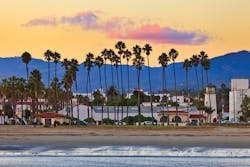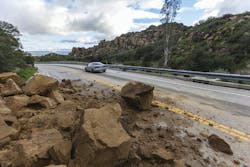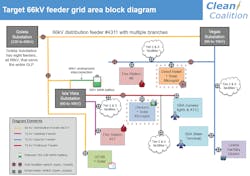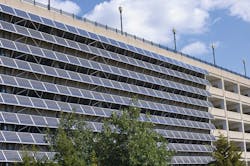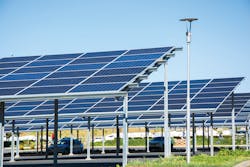Santa Barbara Prepares for New Normal of Natural Disasters and Power Shutoffs
Santa Barbara, California, U.S., sits between a south-facing portion of the Pacific shoreline and steep crags of the Santa Ynez Mountains. It is the county seat and most populous city in a county that also bears the name Santa Barbara. Interestingly, it is the birthplace of the Egg McMuffin, which was invented at the McDonald’s on upper State Street. It also is home to the University of California, Santa Barbara (UC Santa Barbara), and a stop on Amtrak’s Pacific Surfliner line.
Santa Barbara is 100 miles (161 km) to Los Angeles along U.S. Highway 101, which slices through the middle of town. The city’s historic mission buildings and much of the downtown area were damaged in a 1925 earthquake, which killed 13 people. However, the discovery of the Summerland Oil Field and one of the world’s first offshore oil drilling projects spurred rapid expansion of the city throughout the 20th century.
Wildfires and the damage they cause have kept pace with the growth of the area. The 1964 Coyote Fire incinerated 106 homes and scorched 67,000 acres (27,114 hectares). The small but swift Sycamore Fire destroyed 200 homes in 1977. The 1990 Painted Cave fire burned down 500 homes in just hours, and 2008’s Tea Fire swept through Santa Barbara and the neighboring town of Montecito, destroying 210 houses. In 2017, the Thomas Fire, which became the largest wildfire in modern California history at the time, burned 281,900 acres (114,081 hectares) in Santa Barbara, 1050 structures were lost in all by the time the fire was contained.
With wildfire seasons lengthening, unpredictable rains causing mudslides and public safety power shutoffs (PSPS) becoming the new normal, Santa Barbara and other California cities can no longer rely only on their utility’s transmission infrastructure. Santa Barbara has started exploring how to become more energy self-reliant and has developed long-term strategic energy plans to build out its local grid capacity.
Sundowners and Mudslides
One factor worsening fire conditions in Santa Barbara are the infamous sundowners. This local meteorological quirk occurs when high winds sweep up to 60 mph (97 kmph) straight out of the north toward the city and the Pacific Ocean, gaining heat and drying out along the way. They are called sundowners because they tend to blow when the sun is setting, and they often bring increased danger during wildfire season.
Sundowners also precede the Santa Ana winds, which typically arrive a couple of days after sundowners. Santa Ana winds come out of the northwest and can reach tropical storm strength, with gusts up to 75 mph (120 kmph). Either of these uniquely Californian winds can quickly turn a minor scrub blaze into a conflagration thousands of acres wide before firefighters can respond.
The July 2016 Sherpa Fire set the Santa Ynez Mountains ablaze north of Santa Barbara and moved south toward the city as sundowner winds kicked up at speeds of 35 mph (56 kmph). The disaster resulted in evacuations of campgrounds and some residences. Southern California Edison (SCE) responded by shutting down transmission lines that passed through the fire’s path, cutting off power to about 20 customers.
In January 2018, heavy rains and flash flooding triggered mudslides in Santa Barbara County and devastated Montecito, killing 23 people, washing homes away and temporarily closing down Highway 101.
Statewide Power Shutoffs
In September and October 2019, SCE shut off electricity to select areas of Santa Barbara, Montecito and Goleta in a PSPS intended to prevent high winds from sparking a destructive wildfire. The utility provided advanced warning of the shutoff and guided the public to online outage maps, so they could monitor how long power might be out in their area. According to its website, SCE allowed customers to file claims for spoiled food and medicine as a result of the PSPS.
At the same time, Pacific Gas and Electric Co. (PG&E) and San Diego Gas & Electric (SDG&E) — the other of California’s big three utilities — shut off power to about 2.5 million people. In the aftermath of the high windstorms, PG&E told U.S. Judge William Alsup on Oct. 30, 2019, it had identified 44 points along transmission lines where vegetation damaged equipment and would have caused sparks and arc flashes capable of starting a wildfire. In all, the utility found some 300 issues in its post-shutdown inspections.
In May 2020, Santa Barbara released an updated draft of its community wildfire protection plan, which contained lessons learned from recent disasters. Funded by US$310,000 from the California Department of Forestry and Fire Protection, the plan expands the coverage of the city’s vegetation management program. Earlier that same month, area firefighters had to combat fire as well as pandemic conditions. First responders to the Hollister Fire near Santa Barbara, which blazed across about 150 acres (61 hectares), sanitized their equipment, worked in small groups and firefighters assigned to those groups did not move to other groups.
"We're taking our temperatures daily, actually twice a day we're taking our temperatures. And we're doing continued self-checks throughout the day for symptoms that might be indicative of COVID-19," Captain Daniel Bertucell told KEYT-TV, channel 3 in Santa Barbara.
Transmission Lifeline
Except for a few outlying areas serviced by PG&E, most of the Santa Barbara area falls within SCE’s service territory. David Song, an SCE spokesperson, said the area is connected to the rest of the power grid by a pair of 230-kV high-voltage transmission lines, but the lines are located on the same set of transmission towers. The lines stretch across rough, mountainous terrain often beset by wildfires and mudslides, so there is a risk of knocking out both lines at once.
“In the event of an outage on both lines, the Santa Barbara/Goleta area would lose power until one or both of the lines are reenergized, or SCE is able to provide backup service to the area through its lower-voltage 66-kV system,” Song wrote to T&D World in an email.
For its part, SCE is aware of the problem and working toward making the region more energy self-sufficient. On April 26, 2019, the utility announced it was procuring 195 MW of battery energy storage for Santa Barbara as well as Ventura, California, which is just upstream from Santa Barbara from a power transmission perspective. Colin Cushnie, SCE vice president of energy procurement and management, said SCE targeted clean energy resources through an accelerated competitive bidding program to meet this identified need before summer 2021. The solicitation results also support SCE’s clean energy vision for California.
According to Song, all the energy storage contracts have been approved by the California Public Utilities Commission (CPUC).
“None of the seven battery storage contracts executed in 2019 to meet local capacity requirements in the Santa Clara subarea have come on-line yet. While several projects did experience delays of a few months, all projects are expected to come on-line, with most projects expected in March and April 2021,” Song said.
When backup generation is needed in Santa Barbara, the utility typically relies on portable diesel-powered generation sets.
In addition to the storage procurement, SCE completed in 2019 the Santa Barbara County reliability project, which increased the load-serving capability of the lower-voltage 66-kV system in the event of an outage of both 230-kV transmission lines, Song noted. To boot, he added that SCE is working to make the area more wildfire ready by replacing bare wires with covered conductors, adding fire-resistant wraps to protect wooden power poles and installing more composite poles.
Also according to Song, during the strong El Niño conditions in 2015, SCE protected Santa Barbara’s all-important transmission lifeline with “various proactive measures, including increased inspections, reinforcement of structures and advanced staging of equipment.”
Vonette Fontaine, spokesperson for the California Independent System Operator (ISO), said Santa Barbara’s underlying 66-kV transmission system can be used as a backup when the 230-kV lines are out, but added that the capability of the 66-kV system is not enough to serve the Santa Barbara load without local resources.
“Also, the Santa Barbara area is served by the same transmission system that serves the Ventura County area,” Fontaine said. “The planned retirement of the Ormond Beach generation in the Ventura area is being addressed with the addition of a new 230-kV transmission circuit from Pardee to Moorpark 230-kV substations by 2021.”
A More Resilient Region
For the locals’ part, there is a general sense — despite planned improvements and the grid maintenance completed to date — Santa Barbara is going to have to look out for itself if it wants to stop being an energy island. Alelia Parenteau, energy and climate program supervisor for the City of Santa Barbara’s Public Works department, said the city has weathered a history of reliability issues. She added that the city hopes SCE’s planned improvements will address these problems.
“Mostly the downtown corridor was plagued with relatively frequent power outages due to outdated infrastructure. These outages could also take a long time to restore,” Parenteau recalled. “We, and the jurisdictions immediately surrounding us, are at the end of the line and could experience significant challenges should SCE’s limited transmission infrastructure fail during a natural disaster, such as a fire or earthquake.”
According to Parenteau, the city is looking at creating its own energy assurance pathway in the long term.
“We are hoping to expand renewable generation facilities in our area and install storage options that can help carry our community through times of disaster. This is a major area of focus of the city’s energy and climate division and a key strategy in the city’s strategic energy plan, released in 2019,” Parenteau said. “Basically, we are looking to build up our local grid capacity, so that we aren’t as dependent on SCE’s transmission infrastructure. This is a long-term vision.”
Craig Lewis, founder and executive director of the Santa Barbara Clean Coalition, agrees the city needs to find ways to become more energy resilient. The Clean Coalition is a local nonprofit whose stated goal is to accelerate the transition to renewable energy and a modern power grid through policy and project development. According to Lewis, Santa Barbara’s transmission bottleneck can be blamed on how expensive, dangerous and environmentally destructive it is to build power lines in the region. Even if a new redundant transmission corridor were put in on different lines, the city would still be dependent on power generated elsewhere, Lewis explained.
“Edison has been very clear: The transmission connection will go down. It’s when, not if, it goes down. In their filings with CPUC, they are very clear about this. They say when it goes down, it could be down for a couple weeks at a time. So, this is no secret. This is something everyone in the electricity industry knows about,” Lewis said, adding that the last time this happened was the Thomas Fire in late 2017.
Another problem: In the age of more severe wildfires and PSPS, a shutoff in the wrong part of Santa Barbara would knock out power to the rest of the town simply because there is only one way power flows into town. The solution the Clean Coalition and others in Santa Barbara are championing is a combination of solar-plus-storage for maximum energy resilience. Based on internal models, Lewis’ group estimates the Santa Barbara area needs 200 MW of solar power and 400 MWh of energy storage capacity to get through a loss of its transmission connection without power interruption. That 200 MW of solar is five times what the area has right now.
“You might say to yourself, how could that be? Santa Barbara is thought of as a very environmentally conscious population,” Lewis said.
He added that California utilities’ refusal to implement a pro-renewable policy, like a feed-in tariff, has resulted in less solar adoption than you might otherwise expect in an area with abundant sun and green-thinking residents. Put another way, the Clean Coalition would like to see 15% of all parking lots, parking garages and rooftops in the area install solar power to help meet the 200-MW goal. Lewis said these numbers, along with its maps and other data, were developed without any help from SCE and are based on the coalition’s own research on the issue.
Finding Project Partners
Achieving the 400-MWh goal for energy storage will mostly be taken care of by SCE’s planned energy storage projects, noted Lewis.
“Edison has already applied for and gotten CPUC approval for 280 MWh,” he said. “Getting to that magic number will be easy. This time next year, we will be 70% of the way there.”
The Clean Coalition has found partners in its solar build-out in the Santa Barbara Unified School District, which voted back in January to build a solar microgrid project across its entire district.
“When our power was out, I had to scrounge for a place to charge my Leaf, and I realized Santa Barbara is kind of a desert,” Superintendent Cary Matsuoka told the Santa Barbara Independent newspaper. “I had to charge at Peabody and then at some city lots. I learned that it’s a real challenge to charge a car through public tools.”
The district wants to meet 94% of its power needs with solar power, while making the local grid more resilient with energy storage and expanding the number of electric vehicle (EV) charging stations. The district is in the requests-for-proposals phase.
Another partner, UC Santa Barbara is working on a community microgrid. The university also is the primary disaster sheltering site for the area, so it is deemed critical infrastructure. The campus already has about 7 MW of solar capacity but no way to store it yet.
With wildfire seasons lengthening, unpredictable rains causing mudslides and PSPS becoming the new normal, California cities must continue to explore new ways to become more energy self-reliant. They have started taking steps to build up their local grid capacity, so they will not be as dependent on their utility’s transmission infrastructure. At the same time, the big three California utilities also are working toward making the region more energy self-sufficient.
For More Information:
The Clean Coalition | clean-coalition.org
About the Author
Jeff Postelwait
Managing Editor
Jeff Postelwait is a writer and editor with a background in newspapers and online editing who has been writing about the electric utility industry since 2008. Jeff is senior editor for T&D World magazine and sits on the advisory board of the T&D World Conference and Exhibition. Utility Products, Power Engineering, Powergrid International and Electric Light & Power are some of the other publications in which Jeff's work has been featured. Jeff received his degree in journalism news editing from Oklahoma State University and currently operates out of Oregon.
